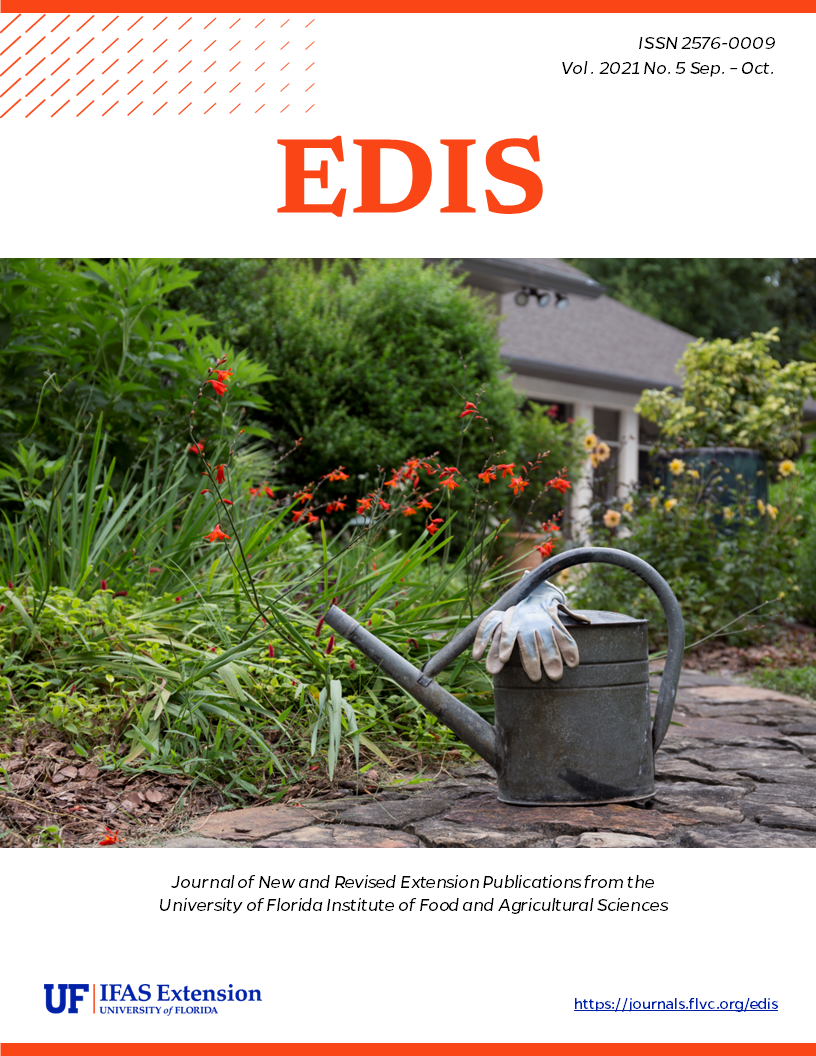Abstract
Passionfruit is a short-lived evergreen perennial vine that produces an aromatic, tropical-tasting fruit. This new 14-page Spanish translation of the UF/IFAS Horticultural Sciences Department provides a description of passionfruit and its various species and cultivars, as well as a guide to culture and management, harvest and storage, its pests and diseases, and food and marketing. By M. Bailey, A. Sarkhosh, A. Rezazadeh, J. Anderson, A. Chambers, and J. Crane. Translated by J. Clavijo-Herrer.
References
Altendorf, S. 2018. “Minor Tropical Fruits: Mainstreaming a Niche Market.” FAO Food Outlook, July 2018. Accessed August 29, 2020. http://www.fao.org/3/ca0239en/CA0239EN.pdf
Baker, C. A., A. Jeyaprakash, C. G. Webster, and S. Adkins. 2014. “Viruses Infecting Passiflora Species in Florida.” Florida Dep. Agric. Consum. Serv. Plant Pathol. Circ.
Baumgartner, J. G. 1987. “Nutrição e adubação.” In Maracujá, edited by C. Ruggiero, 86–96. São Paulo, Brazil: UNESP (São Paulo State University).
Bernacci, L. C., M. D. Soares-Scott, N. T. V. Junqueira, I. R. da S. Passos, and L. M. M. Meletti. 2008. “Passiflora edulis Sims: The Correct Taxonomic Way to Cite the Yellow Passion Fruit (and of Others [sic] Colors).” Rev. Bras. Frutic. 30 (2): 566–576. https://doi.org/10.1590/s0100-29452008000200053
Bora, P. S., and N. Narain. 1997. “Passion Fruit.” In Postharvest Physiology and Storage of Tropical and Subtropical Fruits, edited by S. K. Mitra, 375–386. New York, NY: CAB International.
Campbell, C. W., R. J. Knight, Jr., and N. L. Zareski. 1977. “Freeze Damage to Tropical Fruits in Southern Florida in 1977.” Proc. Fla. State Hort. Soc. 90:254–257.
Costa, A. P., I. Nogueira, J. R. Peixoto, and L. E. B. Blum. 2020. “Screening of Sour Passion Fruit for Reaction to Bacterial Spot and Passion Fruit Woodiness Disease.” J. Agric. Sci. 12 (2): 130–137. https://doi.org/10.5539/jas.v12n2p130
Elliott, M. S., F. W. Zettler, and J. H. Crane. 1991. “Surveys for Viruses of Passiflora Spp. Which Threaten the Passionfruit Industry in South Florida.” Proc. Fla. State Hort. Soc. 104:49–50.
Fischer, I. H., and J. A. M. Rezende. 2008. “Diseases of Passion Flower (Passiflora spp.).” Pest Technology 2 (1): 1–19.
FLEPPC. 1999. “1999 List of Invasive Plant Species.” Florida Exotic Pest Plant Council. Accessed August 30, 2020. https://www.fleppc.org/list/list.htm
FLEPPC. 2019. “2019 List of Invasive Plant Species.” Florida Exotic Pest Plant Council. Accessed August 29, 2020. https://www.fleppc.org/list/list.htm
Knight, R. J., Jr. and J. W. Sauls. 1994. The Passion Fruit. HS60. Gainesville: University of Florida Institute of Food and Agricultural Sciences. https://ufdc.ufl.edu/IR00003395/00001
Knight, R. J. 1972. “The Potential for Florida of Hybrids between the Purple and Yellow Passionfruit.” Florida State Hortic. Soc. 85:288–292.
Knight, R. J., and H. F. Winters. 1962. “Pollination and Fruit Set of Yellow Passionfruit in Southern Florida.” Florida State Hortic. Soc. 75:412–418.
Lima, L. K. S., O. N. de Jesus, T. L. Soares, S. A. S. de Oliveira, F. Haddad, and E. A. Girardi. 2019. “Water Deficit Increases the Susceptibility of Yellow Passion Fruit Seedlings to Fusarium Wilt in Controlled Conditions.” Sci. Hortic. 243:609–621. https://doi.org/10.1016/j.scienta.2018.09.017
Manicom, B., C. Ruggiero, R. C. Ploetz, and A. de Goes. 2003. “Diseases of Passion Fruit.” In Diseases of Tropical Fruit Crops, edited by R. C. Ploetz, 413–441. Cambridge, MA: CABI. https://doi.org/10.1079/9780851993904.0413
Menzel, C. M., G. F. Haydon, V. J. Doogan, and D. R. Simpson. 1993. “New Standard Leaf Nutrient Concentrations for Passionfruit Based upon Season Phenology and Leaf Composition.” J. Horticultural Science 68:215–230.
Menzel, C. M., and D. R. Simpson. 1994. “Chapter 10. Passionfruit.” In Handbook of Environmental Physiology of Fruit Crops, Vol. II: Subtropical and Tropical Crops, edited by B. Schaffer and P. C. Andersen, 225–241. Salem, MA: CRC Press, Inc.
Nascimento, A. V. S., E. N. Santana, A. S. K. Braz, P. F. Alfenas, G. Pio-Ribeiro, G. P. Andrade, M. G. de Carvalho, and F. Murilo Zerbini. 2006. “Cowpea aphid-borne mosaic virus (CABMV) is Widespread in Passionfruit in Brazil and Causes Passionfruit Woodiness Disease.” Archives of Virology 151:1797–1809. https://doi.org/10.1007/s00705-006-0755-6
Newett, S., J. Daniells, and P. Rigden. 1999. “Growing the Crop.” Passionfruit Information Kit Annual Update, Agrilink Series QAL9802. Dept. of Primary Industries, Nambour, Queensland, Australia.
Paull, R. E., and C. C. Chen. 2016. “Passion Fruit.” In USDA-ARS Agric. Handbook Number 66. The Commercial Storage of Fruits, Vegetables and Florist and Nursery Stocks, edited by K. C. Gross, C. Y. Wang, and M. Saltveit, 460–462. Washington, D.C.
Percival, S. S., and B. Findley. 2007. What’s in Your Tropical Fruit? FSHN07-08. Gainesville: University of Florida Institute of Food and Agricultural Sciences. https://journals.flvc.org/edis/article/view/116933
Ploetz, R. C. 1991. “Sudden Wilt of Passionfruit in Southern Florida Caused by Nectria haematococca.” Plant Dis. 75:1071–1073. https://doi.org/10.1094/pd-75-1071
Queensland Department of Agriculture and Fisheries. 2016. “Managing Passionfruit Plantations Affected by Wet Weather.” QLD. Dep. Agric. Fish. 1–4.
Rooney-Latham, S., C. L. Blomquist, and H. J. Scheck. 2011. “First Report of Fusarium Wilt Caused by Fusarium oxysporum f. sp. passiflorae on Passion Fruit in North America.” Plant Dis. 95 (11): 1478. https://doi.org/10.1094/pdis-03-11-0261
Silva, G. S., and M. M. Santos. 2020. “Origin of the Cultivated Passion Fruit Passiflora edulis f. flavicarpa and Genomic Relationships among Species of the Subgenera Decaloba and Passiflor.” Plant Biol. 22 (3): 533–540. https://doi.org/10.1111/plb.13100
Turner, D. W., C. M. Menzel, and D. R. Simpson. 1996. “Short Term Drying of Half the Root System Reduces Growth but No Water Status or Photosynthesis in Leaves of Passion Fruit (Passiflora sp.).” Scientia Horticulturae 65:25-36. https://doi.org/10.1016/0304-4238(95)00849-7
Ulmer, T., and J. M. MacDougal. 2004. Passiflora: Passionflowers of the World. Portland, OR: Timber Press.
USDA ARS. 2020. “Passion Fruit Juice, 100%: Nutrients.” FoodData Central. https://fdc.nal.usda.gov/fdc-app.html#/food-details/1102755/nutrients
USDA ARS OSU. 2012. Plant Hardiness Zone Map. USDA.gov.
USDA Agricultural Marketing Service. 2020. https://www.marketnews.usda.gov/mnp/fv-report-top-filters?locName=&commAbr=PASSIONF-V&commName=PASSION%20FRUIT&className=FRUITS&rowDisplayMax=25&startIndex=1&navClass=FRUITS&navType=byComm&repType=termPriceDaily&type=termPrice
Wunderlin, R. P., B. F. Hansen, A. R. Franck, and F. B. Essig. 2020. “Passiflora.” In Atlas of Florida Plants. Tampa: Institute for Systematic Botany, University of South Florida. Accessed August 29, 2020. https://florida.plantatlas.usf.edu/Genus.aspx?id=891

